Serviços Personalizados
Artigo
Indicadores
Links relacionados
-
 Citado por Google
Citado por Google -
 Similares em Google
Similares em Google
Compartilhar
Stellenbosch Papers in Linguistics Plus (SPiL Plus)
versão On-line ISSN 2224-3380
versão impressa ISSN 1726-541X
SPiL plus (Online) vol.62 Stellenbosch 2022
http://dx.doi.org/10.5842/62-2-908
ARTICLES
On five-level tone contrasts: The case of Dan-Gblewo
Akinbiyi AkinlabiI, II, 2; Firmin AhouaII; Bleu Gildas GondoIII
ILinguistics Department, Rutgers University, USA E-mail: akinlabi@rutgers.edu
IIUnité des langues, littératures et civilisations (LLC), Université Félix Houphouët-Boigny, Ivory Coast E-mail: fahoua2003@yahoo.fr
IIIUniversité Félix Houphouët-Boigny, Ivory Coast E-mail: bleugondo@yahoo.fr
ABSTRACT
The central goal of this research is to propose that no language utilizes more than four level pitches contrastively (from low to high). The central question is whether a five- or six-way contrast represents five or six level tones, or a combination of level tones, contour tones, voice quality, and syllable type. We argue that Dan-Gblewo operates a four-level-plus-creaky-voice system rather than a five-level tone system. We show that Dan must be analysed as such from the empirical, experimental, and theoretical perspectives.
Keywords: tonal contrast, voice quality, creaky voice, Dan-Gblewo
1. Introduction
Broadly speaking, having both contrastive level and contour tones in a single language is a cross-linguistic phenomenon. However, one of the typological features of (West) African language tone systems is that they have a propensity for contrasting level tones, as opposed to contour tones.3Thus, when a West African language is reported to have a contrastive contour tone (as Flik 1977 reported for Dan), it raises some curiosity.
The issue that we examine here is not whether a language can have any number of pitch contrasts, combining both level and contour pitches. The argument is also not whether a language may have any number of phonetic level pitches, as in several levels of downsteps, for example. The central question is whether a five- or six-way contrast represents five or six level tones. The central goal of this research is to propose that no language utilizes more than four level pitches contrastively (from low to high). A language may, in addition, combine some of these four level pitches into contours, resulting in six or more contrastive tones. Empirically, Dan (Ivory Coast) has been cited over and over as the classic example of a West African language with a five-level contrast. The original analysis was made by Bearth and Zemp (1967) and Flik (1977), and is referenced in Vydrine and Mongnan (2008), Gondo (2014), and Odden (to appear). We argue that Dan-Gblewo operates a "four-level-plus-creaky-voice" system. We show that Dan must be analysed as such from both the empirical and theoretical perspectives.4
This suggests that we need new phonetic investigations of other languages with reported five- or six-level contrasts. (See Odden (to appear) for further details.)
2. Reported contrastive pitch levels5
Reported contrastive pitch levels in tone languages vary from two to as many as five or even six. One thing that is often unclear is whether scholars are reporting level pitch contrasts or contrasts including contours and level pitches. By far the most common type of system reported for African languages is a two tone (phonetically H, L) system. These have been represented phonologically as High (H) vs. Low (L), H vs. 0, or L vs. 0. Virtually every family and sub-family of African languages from the North, South, East, and West have languages with two-tone systems.
Three-level tone languages are also common (phonetically H, Mid (M), L). Among the languages with this contrast are Ebira, Ngas (Angas), Peki Ewe, Yoruba, etc. But the contrastive three-level systems are of two types. The first consists of those in which the three levels can occur on any syllable and after any other tone (that is, nine possible combinations of the three tones in bisyllabic words). The other is a system in which the phonetic M is restricted to occur only after a H tone. That is, there are no MH words; only HM words exist. So, the "M" tone can only be perceived after a higher tone. This is traditionally called a "Two-tone plus Downstep" system, and the classic case is Efik (Winston 1960).
Four level tone systems are less common (H, M, M, L). Such systems have a higher M tone and a M tone. The alternatives are Super-High (S-H), H, M, and L, or H, M, L, and Super-Low (S-L). These may be notational variants depending on the researcher. Reported cases include Bariba, Agio Ewe, Grebo, Igede, Yaitepec Chatino, etc.
Even rarer than four-tone systems are reported five-tone and six-tone systems. The reported five-tone systems include Shidong Kam [Tai-Kadai, China] (Edmondson and Gregerson 1992), Benchnon (Gimira) [Northern Omotic, Ethiopia] (Wedekind 1983), Copala Trique [Mexico], Ticuna [Brazil, Peru, Colombia], and Kporo [Cameroon] (Hollenbach 1984). In West Africa, Dan [Cote D'Ivoire] is often cited (Bearth and Zemp 1967, Flik 1977, Gondo 2014). The examples in (1) are of the six-way contrast from five levels in Benchnon.
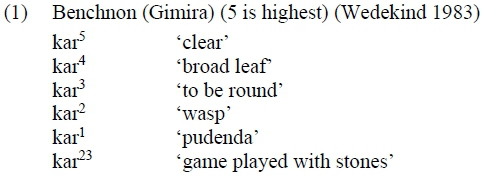
Finally, Dihoff (1976) reported a six-level system in Chori [Plantoid, Niger Congo; Nigeria]. But he notes that dictionary entries require only three underlying tones: Level 1 (highest), Level 4, and Level 6 (lowest). Therefore, it appears that the six levels are not contrastive.
The rest of the paper is structured as follows. We begin with a brief discussion of language location and classification (section 3). In section 4, we look briefly at the syllable and word structures, because these have a bearing on the distribution of L and S-L tones. Section 5 discusses the evidence for the so-called "five-level contrast". Section 6 presents the details of the phonetic evidence backing the creaky voice claim for the S-L tone. Some distributional evidence and restrictions on the S-L tone are presented in section 7. In section 8, we present a brief theoretical implication of a four-level tone system vs. five or six levels. Section 9 concludes the paper.
3. Dan and its dialects, with focus on the Gblewo dialect
The Dan language of Ivory Coast (and Liberia) is classified as belonging to the Southern group (called "Mani-Bandama") of East Mande languages (Gregory and Hailleux 1994). The Southern group also includes Toura (Tura), Gban, Muan (Mwan), Yaouré (Yaure), Gouro (Guro), and Manna.
Dan's major dialects can be found around the following current Ivorian cities: Dan-Klawo in Sipilou; Dan-Gaanwo, Dan-Teewo, Dan-Blongwo, and Dan-Yiiwo in Logoualé; Dan-Waawo and Dan-Blowo in Danané; Dan-Gweetaawo in Santa; and finally, Dan-Slengwo, Dan-Kaawo, and Dan-Gblewo in Man. Since the cities are created without regard to the variety of Dan spoken in them, they are just approximate locations of the dialects. This is the case with Santa Dan, which is Gweetaawo. See the map below (Vydrine and Mongnan 2008: 6).
Dan-Gblewo (spoken in and around Man), the focus of this study, is spoken in five villages: Mélapleu, Kiélé, Biakalé, and Bogouiné 1 and Bogouiné 2. These five towns constitute the Gble Canton. Gondo (2014: 15) provides the following estimated populations of the Gble Canton, following the National Institute of Statistics (INS):

4. Syllable and word structures
We begin with an overview of the word structure of Dan (Gblewo). Vydrine and Mongnan (2008) observe that most of the verb and nominal roots of Dan are now monosyllabic. When compared to neighbouring related languages, the trend is "loss of syllables": final syllables have been lost, resulting in monosyllabic roots. As we will see below, there are still some disyllabic roots, but these are very few indeed.
4.1 The structure of verbs
Monosyllabic verbs can be syllabically open or closed. Syllables can only be closed by a velar nasal, and closed syllables can only occur word-finally. Syllables can occur with or without an onset cluster, in which C2 can only be a liquid or a glide. Syllables can occur with a short vowel or a long vowel, as the examples in (2a) and (2b) show. Finally, a long vowel cannot co-occur with a coda nasal; there are no CVVn or CCVVrj syllables. Except for reduplicated items and compounds (both of which are non-roots), long vowels are restricted to initial syllables of disyllabic roots6. Therefore, there are no CVCVV roots.7
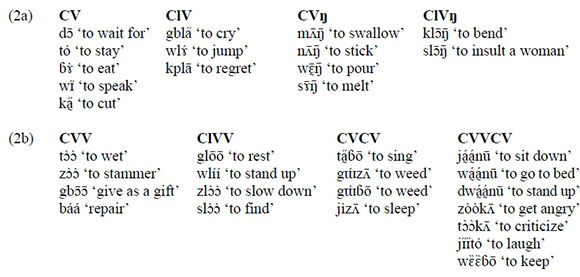
4.2 The structure of nouns
The structure of nouns is not different from that of verbs, as the forms in (3a) and (3b) show. The same syllable structures found in verbs are also the ones that occur in nouns. Therefore, nouns are structurally the same as verbs.
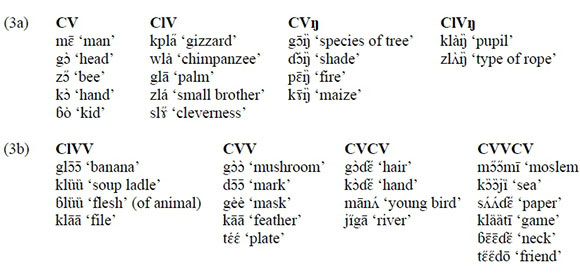
5. Does Dan-Gblewo have a five-level tone contrast?
Using data from Dan-Gweetaawo (Santa), an Eastern Dan dialect, Bearth and Zemp (1967) and Flik (1977) analysed Dan as a five-level tone system (see also Vydrine and Mongnan 2008). But the language has several other Eastern dialects, including Yiiwo (Logouale), Blongwo (Sangouiné), and Gblewo (Man).8 On the basis of the analysis of Santa, all dialects have been analysed on the assumption of this five-level contrast, comprising S-H, H, M, L, and S-L.9 However, a closer look at Dan-Gblewo shows that there are only four pitch levels. The fifth tone, S-L, is a low pitch ending in creaky voice - not a distinct level - and it is more restricted than the other tones.
5.1 The surface distinction
In establishing the so-called "five-way tone distinction" in Dan, the usual practice is to cite the monosyllabic examples in (4) and/or one other example. The examples in (4) provide prima facie evidence for a five-tone system, no doubt. Upon close examination, however, we identified a total of three such examples in the Dan-Gblewo (Man) dialect and one each in two other dialects, namely Dan-Waawo (Danané) and Dan-Blongwo (Sangouiné).

There are no five-way distinctions for any disyllabic items in any dialect. In all the other varieties, there is at most a three- or four-way distinction for any monosyllabic item (see Flik 1977 for comparative evidence).
What stands out in the Dan-Gblewo examples in (4) is that the assumed contrast between the L and S-L tones is one between a noun and an ideophone. Ideophones are known to contain segments and prosodies that are absent in the rest of a language. In Yoruba, for example, there is no vowel length contrast in the regular lexicon. But long vowels occur in ideophones! Therefore, if one was looking desperately for vowel length contrast in Yoruba, one can simply put a verb and an ideophone side by side: gbà 'take, accept' and gbàà '(onomatopoeic sound of a slamming door)'. Pairs like this prove nothing because they can be employed to prove virtually anything.
We now turn to the phonetic evidence showing that the fifth tone in Dan-Gblewo, the so-called "Super-Low" tone, is not a distinct level.
6. Dan as a four-level-plus-creaky-voice language
With this background on Dan syllables and roots, we are now ready to identify exactly what kind of restrictions affect the distribution of the S-L tone, beginning with the phonetic evidence.
Phonetically, the beginning F0 points of the L and the S-L may be similar, or the S-L may even begin with a slightly higher F0; it is the end points that differ. There is a drop in pitch at the end of the S-L tone, which does not occur in the L tone. In addition, there is a marked creakiness associated with the S-L tone.
(6) [gbà] 'antelope' vs. [gbä] (onomatopoeic sound)11
Following Keating, Garellek and Kreiman (2015), we assume that prototypical creaky voice has the following three key properties: (a) low rate of vocal fold vibration (F0), (b) irregular F0, and (c) constricted glottis: a small peak glottal opening, long closed phase, and low glottal airflow. These characteristics can be seen clearly in the waveform of the so-called "Super-Low" tone in (6b). The clearest distinction is the irregular fold vibration (aperiodic voice) in (6b).
6.1 Phonetic experiment
We sought to find out whether the difference between the L and the S-L tones in (6) was consistent. Therefore, we performed an experiment to test the hypothesis.
6.2 Data recording
The data for this study was recorded by three native speakers (two males and one female) in March 2016. One of the two male speakers (G. Gondo) is a native speaker linguist and co-author of this paper.
The sound recordings were made using a Marantz Professional PMD670 Portable Solid-State Recorder, generating .wav files. Each consultant wore a head-mounted microphone to maintain a constant distance from the mouth. The data was recorded in the sound booth of the Félix Houphouët-Boigny University.
The following five Dan-Gblewo target words in (7) were placed in the carrier phrases in (8).12

The reader will immediately notice that each of these items is disyllabic, and that both syllables have the same tone. Since most nouns are monosyllabic, each item is either a compound or a noun plus modifier. The identical tones result from a process of "one-step" rightward tone spread (see Akinlabi, Gondo, Yacoubou-Mamadou and Mitchley 2019). The tone of the first syllable is the crucial tone.

There were six recordings of each speaker on the same day, three for each carrier phrase. Each phrase, with each of the target words, was repeated three times. Each carrier phrase recording with all five target words rendered 15 tokens for each speaker. To control for pitch range, for the first recording we asked each speaker to speak as if talking to someone sitting beside them. For the second recording we asked them to speak as if they were talking to someone across a large room. And for the third recording we asked them to speak as if they were talking to someone outside the room. In total, each speaker produced 90 tokens of the phrases. The cards on which the phrases appeared were randomized before each recording.
6.3 Data analysis
The recorded data was segmented in Praat. For this analysis, our focus is on comparing the L tone L and the S-L tone. Only the first syllable of each target word was measured. The mean f0 of approximately 20ms at the beginning and at the end of each tone (L and S-L) was calculated, both when the target word was sentence-final and when it was not. Some of the intervals (mostly those of the S-L tone) yielded "-undefined-". For those cases, the values were obtained manually through the Praat "get pitch" command.
For some S-L tones, the creak was so discernible that it prevented the pitch tracker from showing up, so we had to lower the "voice threshold" (from .6 to approx. .3) in order to see the pitch. One of the characteristics of the S-L tone that we observed was that the pitch drop was almost abrupt and occurred a few milliseconds after the onset of the pitch track (around the beginning of the vowel).
6.4 Results and statistics
The table below presents the means and standard deviations of the f0 measurements. "Excursion" denotes the trajectory of the tone, with "onset" being its start and "offset" its end.
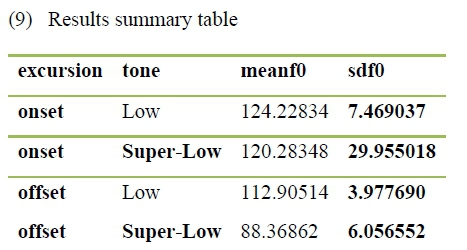
6.5 Statistical analysis
The mean F0 at the offset of the L tone is on average 25Hz higher than the mean F0 at the offset of the S-L tone. A 2-sample t-test indicated that this difference is significant (p < 0.001) when the alpha level is: Alpha = 0.05. The mean F0 at the onset of L vs. S-L, on the other hand, did not yield any significance (p = 0.04).
The difference between when the target word is sentence-final as opposed to when it is not did not yield any significance (p = 0.29) - see Figure 4 below.

6.6 Phonetic conclusion
Our goal was to find out whether the difference between the L tone and the S-L tone in (6) was consistent, and whether Dan-Gblewo contrasts five level tones. The conclusion is that the difference in the end points of the L and the S-L tone is consistent. Secondly, Dan-Gblewo does not contrast five tone levels. The so-called "fifth level" of Dan-Gblewo is a creaky voice quality added to a low pitch, which apparently makes the pitch fall. Therefore, we call Dan-Gblewo a "four-level-plus-creaky-voice" language.13 It is important to stress that the S-L tone can be realised on a long or short vowel (see (7) above).14
7. Distributional restrictions of the S-L tone
In this section, we will briefly describe a few distributional restrictions of the S-L tone. These restrictions show that the S-L tone is not as freely distributed as the other tones are.
7.1 No S-L contrast in monosyllabic CVV and CV
Dan has vowel length contrast, namely long vs. short vowels. In the major lexical items (nouns and verbs), however, the length contrast is absent in monosyllables with S-L tones. That is, there is no contrast between CVV and *Cv. When there is a long vowel with a S-L tone, there cannot be a short vowel form with a S-L tone, or vice versa.
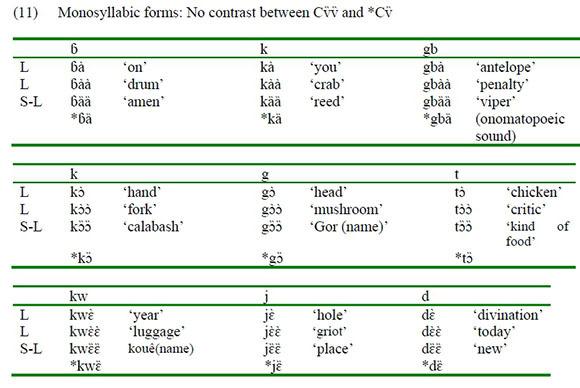
The claim is that there are no contrastive monosyllabic CV and CVV words with S-L tone whose only difference is the vowel length. This observation is crucial because the lexicon is skewed such that both the CV ~ CV contrast and the CVV ~ CV contrast are absent.
The above claims require some clarification. In general, items that have no prosodic size restrictions, such as affixes (e.g. [süi]), clitics (e.g. [6a] possessive marker), prepositions (e.g. [tä] 'on') etc., can have a S-L tone. And the third-person anaphoric pronoun [ë] is also associated with a S-L tone. But since these items belong to closed classes with no contrasts, they do not constitute counterexamples to our claims here.
In summary, the claim made in this section is that the distribution of the S-L contains a systematic gap. In monosyllabic monomoraic forms, there is no CV item with a S-L in the verbs and nouns. We found not a single example that is not an ideophone from Vydrine and Mongman's (2008) dictionary. While the L tone can contrast on both monomoraic and bimoraic syllables (CV and CVv), only CVV is possible with monosyllabic roots. Therefore, the clitics, prepositions, and pronouns noted above must be analysed as bimoraic.15
7.2 L and S-L merge in CVN syllables
In CVN and CCVN syllables, only L ~ S-L is possible: both L ~ L and S-L ~ S-L are ruled out. The implication of this is that the S-L tone starts as L, and falls, with creaky voicing.

8. Theoretical implications
Finally, we turn to a discussion of the theoretical implications and predictions of a four-level tone language vs. a five-level tone language for feature theory. Our point of departure is Yip (1980) and Pulleyblank (1986). Yip proposes that the overall pitch range can be divided into two registers with the feature [Upper]. In addition, she proposes that each register can be further divided into two subregisters with the feature [High]. Pulleyblank (1986), citing personal communication with M. Halle, replaces Yip's feature [High] with the feature [Raised], as follows (H-M is Higher-Mid):
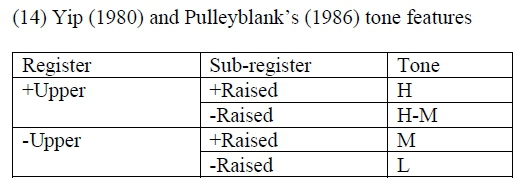
Together, the two features predict a maximum of four contrastive level tones universally. But as Odden (to appear) notes, "there is no universal mapping between inventory and (featural) analysis. Rather, the featural analysis must be discovered by seeing how tonemes group under phonological rules". Therefore, the features in (14) can also be applied to a differently named four-level system like the one in (15), among others.
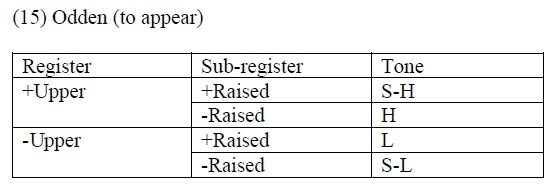
However, the feature structure in (14) does not predict the reported five- and six-way level tone systems. While the sub-registers can be split to accommodate those reported five- and six-way level tone systems, splitting any sub-register into two implies splitting all others. If each of the four sub-registers is split into two, this predicts that it should be possible to have eight-level tones in some language. This is not only impractical, it is improbable.
While it is possible to perceive many levels of non-contrastive tonal downstep (since downstep depends on the pitch height of preceding tone), the question remains whether eight contrastive levels are perceptible, since the prediction is that the eight levels will exist on monosyllabic, monomoraic items.
Theoretically speaking, if languages with five-level tones (as Dan has been analysed as having) exist, then we expect languages with six-, seven-, and eight-level tones. Since nothing like this has been reported, we assume that there are in fact no eight-level tone systems. As we showed in section 6, the L and S-L tones begin at the same pitch level. Therefore, Dan (Gblewo) is in fact not a five-level tone system, but a "four-level-plus-creaky-voice" tone system.
But we can actually stretch the Yip/Pulleyblank system to account for a six-level system by splitting the sub-registers into three, instead of two. Such stretching basically abandons the original system.
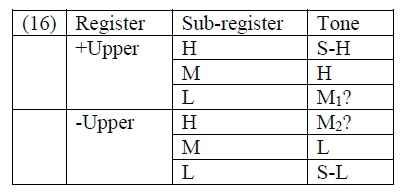
The feature system in (16) appears to be more phonetic than phonological. It makes three levels possible within each register. It is probably more useful to account for intonation registers rather than contrastive tone levels.
So, what does a re-analysis of Dan as a four-level tone system buy us theoretically? Perhaps an advantage is that we are able to provide additional support for the tone feature structure of Yip (1980) and Pulleyblank (1986), and we can constrain what type of tone systems exist. Dan is not an example of a five-level tone system, the existence of which is doubtful in West Africa. The other so-called "five-" and "six-level" tone systems should be re-examined to see if they are made up of four-levels plus some phonetic feature, like voice quality or glottal constriction.
9. Conclusion
In this paper, we have re-examined the analysis of the Dan language using another Eastern Dan dialect, Gblewo. We have shown that Dan-Gblewo operates a four-level-plus-creaky-voice tone system. The question is not whether a language can have any number of pitch contrasts, both level and contour. The central question is whether a five- or six-way contrast represents five or six levels. We have shown that Dan-Gblewo does not operate a five-level tone system.
References
Akinlabi, A., G.B. Gondo, T.-N. Mamadou and H. Mitchley. 2019. The Phonology and Syntax of Tone Spreading in Dan. Paper presented at the 50th Annual Conference on African Linguistics, 2225 May 2019, University of British Columbia, Canada.
Bearth, T. and H. Zemp. 1967. The phonology of Dan (Santa). Journal of African Languages 6: 9-29. [ Links ]
Bolli, M. and E. Flik. 1976. Phonological statement: Dan (Blossé). Two Studies in Ivory Coast. Language data: Africa series; publication 5. Huntington Beach, CA: Summer Institute of Linguistics. [ Links ]
Dihoff, I. 1976. Aspects of the Tonal Structure of Chori. Unpublished PhD dissertation, University of Wisconsin. [ Links ]
Edmondson, J.A. and K.J. Gregerson. 1992. On five-level tone systems. In S.J.J. Huang and W.R. Merrifield (eds.) Language in context: Essays for Robert E. Longacre. SIL & University of Texas at Arlington. pp. 555-576.
Flik, E. 1977. Tone glides and registers in five Dan dialects. Linguistics 15: 5-60. https://doi.org/10.1515/ling.1977.15.20L5 [ Links ]
Gondo, B.G. 2014. Etude Phonologique et Morphosyntaxique en Dan-Gblewo. Unpublished doctoral dissertation, Félix Houphouët Boigny University. [ Links ]
Hollenbach, B.E. 1984. The Phonology and Morphology of Laryngeals in Copala Trique. Doctoral dissertation, University of Arizona. [ Links ]
Keating, P., M. Garellek and J. Kreiman. 2015. Acoustic properties of different kinds of creaky voice. Available online: https://pages.ucsd.edu/~mgarellek/files/Keating_etal_2015_ICPhS.pdf (Accessed 5 September 2021).
Odden, D. 1995. Tone: African languages. In J. Goldsmith (ed.) The handbook of phonological theory. Oxford: Blackwell. pp. 444-475. [ Links ]
Odden, D. (To appear). Tone in African languages. In R. Vossen (ed.) Handbook of African Languages. Oxford: Oxford University Press.
Pulleyblank, D. 1986. Tone in lexical phonology. Dordrecht: Reidel. [ Links ]
Vydrine, V. 2009. On the problem of the Proto-Mande homeland. Journal of Language Relationship 1: 107-142. https://doi.org/10.1515/9783110452754-005 [ Links ]
Vydrine, V. 2016. Tonal inflection in Mande languages: The cases of Bamana and Dan-Gweetaa. In E.L. Palancar and J.L. Leonard (eds.) Tone and inflection: New facts and new perspectives. Mouton De Gruyter. pp. 83-105. https://doi.org/10.2307/j.ctvgc6162.3
Vydrine, V. and A.K. Mongnan. 2008. Dictionnaire Dan - Français (dan de l'Est) avec une esquisse de grammaire du dan de l'Est et un index français-dan. St. Petersburg: Nestor-Istoria. [ Links ]
Wedekind, K. 1983. A six-tone language in Ethiopia. Journal of Ethiopian Studies 16: 129-156. [ Links ]
Winston, F.D.D. 1960. The Mid tone in Efik. African Language Studies 1: 185-192. [ Links ]
Yip. M. 1980. The Tonal Phonology of Chinese. Unpublished doctoral dissertation, Massachusetts Institute of Technology. [ Links ]
Yip, M. 2002. Tone. Cambridge: Cambridge University Press. [ Links ]
1 A version of the paper was presented at ACAL 47 (2016) at the University of California, Berkeley. We are grateful to the participants at the conference, especially Sharon Rose who asked us about voice quality. Two reviewers made insightful comments on an earlier version, which were very beneficial. In addition, we also acknowledge comments from Thomas Bearth, which led to improvements in this version. Finally, we are indebted to Issouf Djarrassouba and Tadjou-Ndine Mamadou Yacoubou for help with segmentation and statistical analysis. This research on Dan was conducted during a Fulbright Fellowship awarded to Akin Akinlabi in 2015-2016.
2 Corresponding author.
3 This is not meant to imply that West African languages do not have contour tones; however, the contour tones are usually derived from level tones.
4 Using comparative historical evidence, Bolli and Flik (1976) propose that Proto-Dan had a five-tone system that reduced to four tones in some dialects of Dan. Vydrine (2009, 2016) proposes this five-tone analysis for Dan (Gweetaa). Our analysis here suggests that Proto-Dan operated a four-tone system that has become five tones in Gweetaa dialect, but still four-level tones in Gblewo.
5 This section relies heavily on Odden (1995, to appear) and Yip (2002). Readers should see these works for additional details.
6 None of the CVVCV forms here are actually disyllabic roots; they are all CVV roots plus a suffix.
7 Tones are indicated as follows: V = Super-High, V = High, V = Mid, V = Low, and V = Super-Low.
8 There are reportedly about 40 varieties in total (Gondo 2014).
9 But see Flik (1977) who proposes that not all dialects have the five levels, and proposes four contrasts for Gblewo (Man).
10 The purpose of this table is just to show the surface five-way distinction, and not to compare Gblewo and Gweetaawo. The [gba] paradigm is well established for Gweetaawo (see also Vydrine 2016).
11 One reviewer points out that we have one illustrative example waveform of the L and S-L. This is the case because all of the waveforms that we have for these pitches resemble the illustrative example here. Therefore, including more will simply be a duplication.
12 We used disyllabic forms with identical tones on both syllables in the experiment because, except for function words, there are no monosyllabic words with a short vowel and a S-L tone. In addition, in disyllabic words the S-L tone only occurs with a long vowel on the initial syllable. So it is quite difficult to control for vowel length.
13 A reviewer asks why the creaky voice accompanies only the L pitch and not the other pitches. We guess that since the L pitch already has the lowest glottal vibration, transition to creaky voicing is more natural.
14 But see additional restrictions in section 7 below.
15 We leave aside the question of whether tone spreading turns the second syllable bimoraic in words like wʌ̏ʌ̏nʌ̏ "pity-child".














